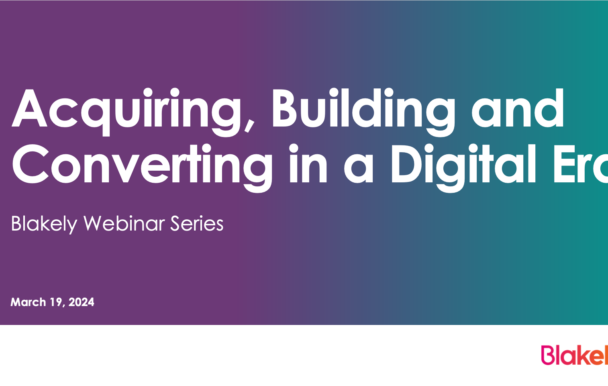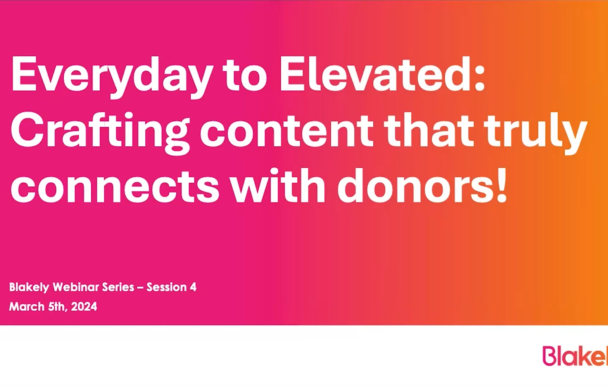6 things Blakely learned at IFC & AHP International
Professional development and support of the non-profit sector are so important to us at Blakely. That’s why we sponsor, speak at, attend, and generally support fundraising conferences at home in Canada, with our American friends, in Europe, the UK, and beyond!
During the week of October 16 – right in the middle of year-end fundraising madness – a number of fundraising strategists in our organization were privileged to attend one of two conferences: the International Fundraising Congress in the Netherlands (IFC) and the Association of Healthcare Philanthropy’s (AHP) International Conference, held in New Orleans this year.
Here are our top 6 takeaways:
The more different we are, the more we’re the same
We may have different markets and experiences and look at the world differently, but in fundraising we’re dealing with the same challenges and opportunities: how to find new audiences of people who want to give to our causes (and stay with us for the long-term), how to inspire people to do more, how to fix systemic issues in our organizations, how to deal with the leadership crisis within the sector… the list goes on. The solution? Have tough conversations in our teams and in the industry that drive real change and action.
Assume people are starting with positive intent
An understanding of diversity is important to everyone but not everyone is doing it well. Part of what gets in the way is not giving someone the benefit of the doubt. If you instead assume people are coming from a well-intentioned place, if they take a misstep, give them the opportunity (in a safe space) to learn about why it’s a misstep, clarify it for them, and allow them to learn. It’s about the conversation – silence is the problem. And don’t be scared to say that you just don’t know; it’s not a sign of weakness, and will help to make these conversations a little easier.
Constant learning is of critical importance
When you attend a conference, and are immersed in a learning environment, the importance of constant learning really hits home. It allows you to look at your work with fresh eyes, but it also recharges you, and reminds you of why you got into this area of work in the first place.
Changing up the “Donate” button
In Tom Ahern’s session at IFC, he had one very simple – yet incredibly powerful – slide talking about the “Donate” button. We all use it, and yet it really stays the same from organization to organization. What if we added something to it? “Feeling angry? Donate now!” “Join the Revolution! Donate Now!” “Make Change! Donate Now!” Agree? Yay Tom!
What do we do with Millennials?
So many charities have their eyes on the shiny object: millennials. They want to engage them, involve them, and inspire them to give. Those of us who are more pragmatic think they need to be low on the priority list. What’s our millennial fundraising strategy? We wait until they’re 45 and then ask them.
But some are thinking differently. Our new EVP at Blakely, Amy Pawluk, attended a session where WaterAid UK shared a study they did with millennials where they found that the drivers for acquisition for millennials were different than other donors; it was about the effectiveness of the charity’s work and whether the charity’s beliefs and values matched their own. So you can’t just broadcast your message; you must change the way you communicate, let millennials choose what they want to see and how they want to see it.
Or, you can just hire them and support them to become leaders and donors! (We loved this Globe & Mail article that our friend Caroline Riseboro shared.)
The practice of gratitude
At AHP International, Bruce Bartoo, Chief Philanthropy Officer at Medstar Health, spoke about when you approach a patient or their family with an ask, be sure give them opportunities to speak of their gratitude, and the money will follow. The foundation staff educates hospital staff on how to accept a thank you, i.e. never say “Oh it was nothing” (because they perform that surgery 10 times a day), acknowledge that for the patient that is the only time they’ll experience it. It was their LIFE and their LIFE was saved. The practice of gratitude has led to measurable increases in staff and patient satisfaction across the health system. In short, being thanked feels good!
As you can see, we love to learn and we really love to share! Be sure to check us out at these upcoming conferences and sessions!
CAGP Luncheon
New Trends and Tactics in Planned Giving Marketing
AFP Congress 2017
Monetizing Your Brand: How Heart & Stroke Used their Rebrand to Inspire Donors to Give
How to Make Waves Without Drowning
AFP International 2018
The Top 10 Strategies for a Successful Monthly Giving Program
Transforming Relationships by Managing Mid-Level and Legacy Donors Together!








